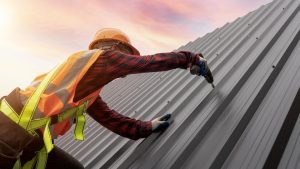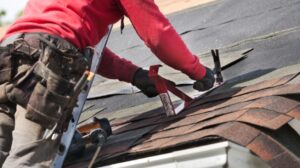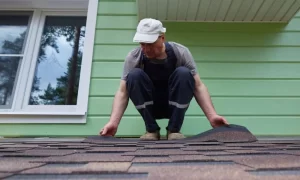
A person has plans to invest in a new home. This means building a structure that will shelter you from the elements of nature and serve as a space where you can live with your family and friends. This, however, will cost money, so you have options on how to save and fund construction. There is financing available, but this might eat up a part of your income which you could have spent on other amenities such as food and clothing. In addition to the cost, there is also the matter of getting the right contractor for the job. In this article, we will discuss things to consider when choosing a new roof.
1. What Kind of Roof Do You Want?
Roofs come in many shapes and sizes, from flat to steeply pitched. A steeply pitched roof is best for homes located in areas with heavy snowfall, where a steeper pitch helps move the snow off the roof faster. A flat or low-pitched roof is better for homes located in areas with less annual snowfall.
The material your new roof will be made from also impacts its appearance and durability. Slate, tile and wood shingles are more expensive than asphalt shingles, but they’re also more durable and last longer. It’s a good idea to pick a professional roofing company to work with you. When deciding what type of material you want for your new roof, think about how long you plan on living in your home and how well it will hold up over time. Here are some types of roofs.
Metal Roofs
Metal roofs are made from aluminum or steel and can be found in various colors and styles. They’re lightweight, durable and easy to install. They also offer good insulation against heat loss in winter and heat gain in summer. However, they aren’t as fire resistant as other roofs, which means they can only be used on homes that don’t have close neighbors.
Gable Roof
The gable roof is one of the most common roofs and is formed by two sloping planes intersecting at right angles. It resembles a triangle when viewed from above, hence the name “gable.” This type of roof is commonly used on homes, barns, garages and other residential buildings. A gable roof can be constructed with either built-up or structural steel trusses.
Clipped Gable Roof
A clipped gable roof has two slopes that extend beyond the walls of the building to create overhangs on all sides of the building. These overhangs help protect the walls from rainwater and snow accumulation during winter. Sometimes referred to as a Dutch Gable or Crowfoot Gable, this type of roof design provides additional storage space and aesthetic appeal for your home’s exterior appearance.
Gambrel Roofs
A gambrel roof has two sloping sides that come to a point at the top edge of the roof. The lower slope is much steeper than the upper slope, typically about 5 degrees or less. This type of roof design is often used for barns, but it can also be used for residential homes with an exposed attic area above the main living space.
Hip Roofs
A hip roof has four sloping sides – two on each side of the house – that come together at each corner of the building to form a ridge line running down the center of the house’s exterior walls. Hip roofs are sometimes called pyramid roofs because they resemble pyramids with square bases and narrow tops.
2. What Kind of Shingles Do You Want?
There are many different types of roofing shingles on the market, but they all fall into one of three categories: wood, fibreglass, or asphalt. The type you choose will depend on your budget and what you want from your roof.
Wood Shingles
Wood shingles, also known as shakes, are made of real wood and have a natural appearance that can complement any home style. They’re usually heavier than other shingles and can be damaged by high winds or heavy rain. Wood is more expensive than different types of shingles but lasts longer and looks better over time.
Fibreglass Shingles
Fibreglass is a composite material from recycled glass, plastic, and mineral fillers such as quartz or granite. Fiberglass shingles are lightweight (about half the weight of asphalt), low maintenance, and fire-resistant, and come in various shades to match any home exterior. Fibreglass does not fade in sunlight as asphalt shingles do, but it may lose its color if exposed to too much sun over long periods.
Asphalt Shingles
Asphalt shingles are also susceptible to damage from ice dams in cold climates because they don’t shed snow well – they slide off easily when they get wet and weigh down the upper edge of the roof so much that it pulls away from the lower edge and creates an ice dam below the eaves. Ice dams can cause severe water damage inside your home.
3. How Many Budgets Do You Have?
Another thing you need to consider when choosing a new roof is how much money you have in your budget. The cost of installing a new roof varies depending on the material used and size. For example, asphalt shingles are cheaper than metal roofs, but they don’t last as long as metal roofs and require more maintenance. If you have enough money in your budget, you can choose any material for your house’s roof which will look great on your home. However, if you’re on a tight budget, it’s best to stick with asphalt shingles because they’re cheaper than metal roofs, and they’ll last just as long as metal roofs do without costing too much money upfront.
4. Who Will Be Installing the New Roof?
The type of roofing material you choose will affect how long it lasts and its cost and appearance. The most common materials used for residential roofs include asphalt shingles, metal and tile. Each has its advantages and disadvantages, so it’s essential to know who will install your new roof before making a final decision. Choosing Roofing Company with experience installing that particular material will ensure they install it correctly and without damage to your house or property. A well-installed roof should last as long as 30 years or more. An improperly installed roof can fall apart in just a few years. If you’re paying for the installation yourself, make sure that you hire someone qualified and licensed.
5. When Do You Need the Roof Installed?
Another thing that you need to consider when looking for a new roof is when it needs to be installed. Many different types of roofs are available for homes, but not all of them will last as long as others. Some roofs only need to be replaced after a certain number of years. In contrast, others may require replacement sooner than that, depending on how often they are exposed to the elements or if any damage has been done to them by storms or other natural disasters. The best way to tell if your roof needs replacing is by looking at it carefully and checking for signs of wear or damage from harsh weather conditions like heavy rain or snowfall. If there is any sign of damage or it looks like it may soon break down completely you can consider hiring a Roofing Contractor, it’s time for a new roof.
Wrapping Up
Roof replacement is a big decision that may significantly impact your life. Making the right choice at the start will save you time, money, and headaches further down the road. Roofing companies today use various materials in roofing, from traditional shingle roofs to more modern slate and tile roofs that are more common in upscale neighborhoods. Each has its advantages and disadvantages, so make sure you study before deciding.







